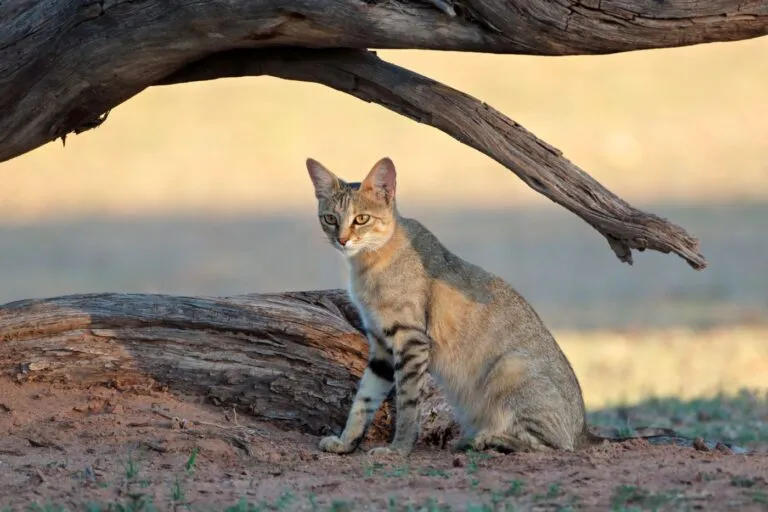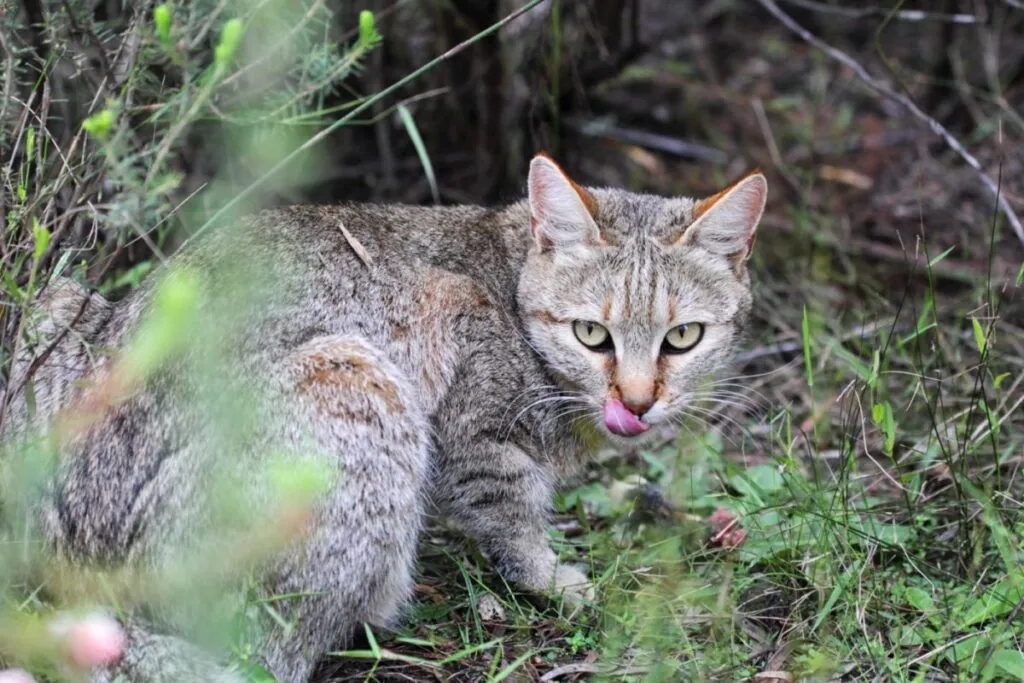Maine Coon
The Maine Coon has become one of the most popular cat breeds in the world. This is probably due to its majestic appearance, robust nature and great character.
The African wildcat, also known as the steppe cat, is regarded as the ancestor of our indoor cats. The resemblance, both in appearance and behaviour, is quite striking. So why is it worthwhile to learn more about the African wildcat? Getting to know these wild creatures offers a series of enlightening moments regarding your own darling feline at home.

© EcoView / stock.adobe.com
The African wildcat is the ancestral mother of all domestic cats.
As the ur-mother of all indoor cats, the African wildcat looks very similar to the felines we’re familiar with: at first glance, one might easily mistake it for a large indoor cat.
However, it moves around on longer legs, giving it entirely different proportions and a movement reminiscent of cheetahs. Also, its long, thin tail differs from our indoor breeds; it tapers to a point and has two to three dark rings towards the tail tip.
From head to tail, members of this species measure roughly 40 to just under 70 centimetres. The tail adds another 30 centimetres.
Art or Reality? You’ve probably seen ancient Egyptian depictions of cats and wondered about their long legs. This stems not from artistic license, but from the actual appearance of the cats from that time, which looked much more like the African wildcat.
The African wildcat sports rather subdued colouring. Shades of red, yellowish-brown, grey, and sandy-yellow dominate; there’s often some striping or “boots”. Distinctive features include reddish-orange patches on the backs of the ears and on the muzzle, a dark stripe along the spine, and black pads on the paws. White markings are often found beneath the eyes.
With these fur colours, the wildcat blends into its habitat, the African savannah or desert. The fur is short with dark tips, lending the animals a slightly speckled look.
Due to its great adaptability, the African wildcat is now found in many natural habitats. It favours deserts, semi-deserts, and savannahs but is also comfortable in forests and even rocky mountain regions up to 3,000 metres above sea level. Only tropical rainforests and snow-covered areas are avoided.
Its primary distribution area spans most African countries, but African wildcats have also been spotted on the Arabian Peninsula and in parts of Southeast Asia and China. They have even been sighted in Sicily and Sardinia, which currently represent the northernmost extent of the African wildcat’s range.
Evidence of domesticated cats dates back to 7,500 B.C. However, it’s believed that cats followed humanity from the first day of sedentary life.
The first “indoor cats” were likely semi-domesticated African wildcats in ancient Egypt. They hunted the troublesome mice and were thus welcomed in homes, storerooms, and even aboard trading vessels.
With the Romans, the African wildcat and its domesticated kin reached Europe around 2,000 years ago and quickly spread. Crossbreeding with the European wildcat is also likely.
The African wildcat is the least endangered wildcat species and fairly common worldwide. However, it is still protected by the Washington Convention on International Trade in Endangered Species.
High habitat tolerance and adaptability enable the cat to survive almost anywhere. Consequently, it has coped well with the destruction of natural habitats.
Apart from occasional traffic accidents, humans pose little threat to the African wildcat. Yet, ongoing interbreeding between pure wildcats and domestic cats is causing the pure wild populations to decline, with increasing numbers of hybrids emerging.
Indoor and African wildcats get along well and can mate without difficulty. Thus, pure African wildcats have become quite rare today.
Suitable as a Pet? The African wildcat is a pure wild animal. It is not domesticated and cannot be kept as a pet.
The African wildcat, like many wildcats, tends to be wary of humans. They are mostly hard to spot as their keen wildlife senses detect humans from afar and avoid them.
Generally, their wariness does not reach the extreme levels of their European cousins. With adequate acclimatisation, the African wildcat will even tolerate increased proximity to humans. In contrast, it is inherently more trusting towards other cats.
Wild African wildcats live alone. They are solitary and carve out territories for themselves, going on nocturnal hunts within these boundaries. The size of the territory greatly depends on the region.
When food is abundant, territories can be smaller. In Kenya, African wildcats with territories of 1.6 square kilometres have been studied, whereas in Saudi Arabia, individuals with territories of around 50 square kilometres have been observed.
The wildcats reach sexual maturity at about one year of age. From then on, they produce a significant number of kittens about once a year. The gestation period lasts only 56 to 68 days.
After the kittens become independent, they sometimes remain as a larger group with their mother. Thus, multiple litters may live together for a while before each cat goes its separate ways as a lone ranger.
A Long Life African wildcats can live up to 16 years.
 © DirkR / stock.adobe.com
© DirkR / stock.adobe.com
The African wildcat’s diet primarily consists of small rodents in all its territories, including mice, hares, hamsters, and small rabbits. Birds like doves, weaver birds, or game birds are also on the menu.
Meals are often complemented by spiders, scorpions, and snakes. The wildcat also enjoys fish. Adult African wildcats can even take down small antelopes or lambs.
These wildcats excel as hunters, stalking their prey, creeping up on it, and then launching a rapid sprint to make the kill. They usually stay on the ground, though they are also adept climbers. Should hunting prove unsuccessful or the opportunity arise, they will eat carrion.
Does your indoor cat drink little? It inherits this from the African wildcat: desert dwellers rarely encounter a watering hole and, therefore, almost entirely satisfy their thirst through their prey. Surprisingly, a mouse contains a fair amount of water.
This genetic legacy is also why, according to many experts, you should not feed your cat exclusively on dry food. Dry food contains hardly any water, and due to their genetics, cats lack a strong instinct to drink enough to make up for this, risking dehydration.
The African wildcat is a highly adaptable wild animal and closely related to our indoor cats. The species itself is not suited to being a house pet, but all modern pedigree cats descend from it. A significant part of this wild cat lives on in every pampered pet—if you look closely enough.
| Particular Features: | Origin of modern indoor cats |
| Temperament: | Wary loners |
| Size: | Length from head to tail base about 40-66.5 cm |
| Weight: | 2.4-6.4 kg |
| Eye Colour: | Greenish-yellow |
| Colours: | Red, Yellowish-brown, Grey, Sandy-yellow |
| Fur: | Short |
| Life Expectancy: | 16 years |
| Origin: | Africa |
Here are some purchase proposals curated by the zooplus editorial team
The products featured have been carefully selected by our editorial staff and are available at the zooplus online pet shop. The selection does not constitute advertising for the mentioned brands.
The Maine Coon has become one of the most popular cat breeds in the world. This is probably due to its majestic appearance, robust nature and great character.
Large eyes and attentively upright ears instantly tell you a great deal about this charming breed of cat: Abyssinians are inquisitive and affectionate towards people.
With its long, dense fur, rounded ears, and intense stare, the Pallas Cat, or Manul, looks rather fluffy, yet somewhat dangerous. However, don't be fooled by its appearance—this is no petting zoo resident. The Manul is a wild animal and considered untameable.